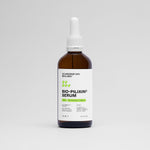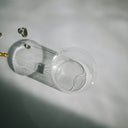Many individuals experience the frustration of dealing with thin hair, particularly when it becomes wet. Understanding how wet hair affects its appearance and health is crucial for anyone looking to improve the condition and look of their hair. In this article, we will delve into this topic, providing insights and solutions for those struggling with thin hair when wet.
Table of content
What happens to thin hair when wet?
When hair is wet, it can appear even thinner than when it is dry. This is primarily due to the way water interacts with the hair shaft. Wet hair becomes more translucent, causing the scalp to show through more prominently, making the hair seem less voluminous. Additionally, moisture can weigh hair down, reducing its natural bounce and making it lie flatter against the scalp. This effect is particularly noticeable in individuals with fine or thin hair.
Moreover, wet hair is in a more fragile state than dry hair. The hair cuticles, which act as protective layers, can swell and become more vulnerable when exposed to water. This increased vulnerability can lead to breakage and split ends, further contributing to the overall appearance of thinning hair. For those with thin hair, this can create a cycle of damage that exacerbates the issue.
As your leading source for hair health information over the past 4 years, we never compromise on accuracy. When it comes to your health, you deserve information you can truly rely on - and earning your trust is our top priority.
Here's how Scandinavian Biolabs ensures every piece of content meets the highest standards of accuracy and integrity:
- Credentialed Experts: Our reviewers are actively practicing doctors and medical researchers
- Stringent Reviews: Content undergoes rigorous editing by subject specialists and review by a practicing doctor.
- Evidence-Based: We rely on well-established research from trusted scientific sources like peer-reviewed journals and health authorities.
- Full Transparency: Our editorial standards, writer credentials, reviewer credentials, correction process, and funding are all publicly documented.
- Independent Voice: While we do promote products, we operate in a vacuum to business operations. Our main goal is just an unwavering commitment to providing medically-sound guidance.
You can count on Scandinavian Biolabs to consistently deliver the trustworthy health information you deserve. Read our Editorial Standards.
Why does thin hair look worse when wet?
The primary reason thin hair looks worse when wet is the loss of volume. Wet hair tends to lie flat against the scalp, reducing any natural lift and making the hair appear less full. Additionally, the translucency of wet strands means that any scalp visibility is heightened, giving an illusion of even sparser hair. Furthermore, wet hair can clump together, which can make individual strands less distinguishable, thus amplifying the perception of thinness.
How to care for thin hair when it’s wet?
Caring for thin hair when it’s wet involves a few strategic steps to minimize damage and enhance volume:
- Use a gentle shampoo: Opt for sulfate-free shampoos that cleanse without stripping natural oils. This helps maintain moisture and prevents your hair from becoming limp.
- Condition wisely: Apply a lightweight conditioner only to the ends of your hair to avoid weighing it down. Leave-in conditioners can also be beneficial for added moisture without heaviness.
- Pat dry, don’t rub: When drying your hair, gently pat it with a towel instead of rubbing. Rubbing can cause friction and damage to the hair shaft.
- Detangle carefully: Use a wide-tooth comb or a detangling brush while your hair is wet to avoid breakage. Start from the ends and work your way up to prevent snagging.
- Air dry or diffuse: If possible, allow your hair to air dry. If you must use a blow dryer, use a diffuser attachment on a low heat setting to add volume without excessive heat damage.
Styling tips for thin hair when wet
Styling thin hair can be a challenge, especially when it’s wet. Here are some effective styling tips to create volume and maintain a healthy look:
- Volumizing products: Incorporate volumizing mousse or spray into your damp hair before drying. These products can help lift the roots and create the illusion of thicker hair.
- Use rollers or braids: After applying your styling products, consider using rollers or braiding your hair while it’s damp. This can add natural waves and volume as it dries.
- Opt for layered cuts: Layers can help create movement and volume, making thin hair appear fuller. Discuss with your stylist the best cut for your hair type.
- Avoid heavy products: Stay clear of heavy gels or creams that can weigh your hair down. Instead, look for lightweight styling agents.
Common mistakes to avoid with wet thin hair
When dealing with thin hair, especially when wet, there are several common mistakes that can worsen the situation:
- Using too much product: Overloading your hair with styling products can lead to buildup and make it appear greasy rather than voluminous.
- Skipping heat protection: If you use heat tools on wet hair, always apply a heat protectant. This is crucial to prevent damage as wet hair is more porous and susceptible to heat-related harm.
- Not addressing scalp health: A healthy scalp is vital for hair growth. Ensure you’re keeping your scalp clean and free of excess oil or product buildup.
- Ignoring hydration: Thin hair can also benefit from hydration. Make sure to drink plenty of water and consider incorporating hair-healthy foods into your diet.
Conclusion
Thin hair can be a source of frustration, especially when wet. Understanding the reasons behind its appearance and how to care for it properly can help you embrace your hair's natural beauty. By implementing the right techniques and styling methods, you can enhance the look and feel of your thin hair, even when it’s wet. Remember, the key is to be gentle, choose the right products, and maintain a healthy hair care routine for the best results.
Tired of Thinning Hair? Try a Clinically Tested Serum.
Looking for a natural way to regrow hair and achieve a thicker, fuller head of hair? Ditch the stinging nettle for hair loss – Bio-Pilixin Serum is a drug-free hair activation serum that delivers clinically tested results.
Here's why Bio-Pilixin is superior:
- Clinically Tested Results: 93% of users saw a reduction in hair loss, and 73% experienced increased hair density.
- Safe and Natural: Unlike harsh chemicals, Bio-Pilixin uses plant growth factors derived from stem cell technology to nourish hair follicles and stimulate growth.
- Fast-Acting: See visible results in as little as 45 days (most typically see results within 150 days).
Stop wasting time on unproven remedies. Bio-Pilixin is the safe, natural serum you've been searching for.
Read more:






